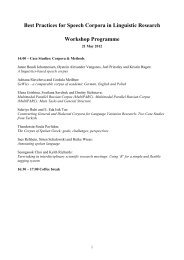96 • 2011 - Hamburger Zentrum für Sprachkorpora - Universität ...
96 • 2011 - Hamburger Zentrum für Sprachkorpora - Universität ...
96 • 2011 - Hamburger Zentrum für Sprachkorpora - Universität ...
Create successful ePaper yourself
Turn your PDF publications into a flip-book with our unique Google optimized e-Paper software.
Multilingual Resources and Multilingual Applications - Invited Talks<br />
Combining various text analysis tools for multilingual media monitoring<br />
Ralf Steinberger<br />
European Commission – Joint Research Centre (JRC)<br />
21027 Ispra (VA), Italy<br />
E-mail: Ralf.Steinberger@jrc.ec.europa.eu, URL: http://langtech.jrc.ec.europa.eu/<br />
Abstract<br />
There is ample evidence that information contained in media reports is complementary across countries and languages. This holds<br />
both for facts and for opinions. Monitoring multilingual and multinational media therefore gives a more complete picture of the<br />
world than monitoring the media of only one language, even if it is a world language like English. Wide coverage and highly<br />
multilingual text processing is thus important. The JRC-developed Europe Media Monitor (EMM) family of applications gathers<br />
about 100,000 media reports per day in 50 languages from the internet, groups related articles, classifies them, detects and follows<br />
trends, produces statistics and issues automatic alerts. For a subset of 20 languages, it also extracts and disambiguates entities<br />
(persons, organisations and locations) and reported speech, links related news over time and across languages, gathers historical<br />
information about entities and produces various types of social networks. More recent R&D efforts focus on event scenario template<br />
filling, opinion mining, multi-document summarisation, and machine translation. This extended abstract gives an overview of EMM<br />
from a functionality point of view rather than providing technical detail.<br />
Keywords: news analysis; multilingual; automatic alerting; text mining; information extraction.<br />
1. EMM: Background and Objectives<br />
The JRC with its 2700 employees working in five<br />
different European locations in a wide variety of<br />
scientific-technical fields is a Directorate General of the<br />
European Commission (EC). It is thus a governmental<br />
body free of national interests and without commercial<br />
objectives. Its main mandate is to provide scientific<br />
advice and technical know-how to European Union (EU)<br />
institutions and its international partners, as well as to EU<br />
member state organisations, with the purpose of<br />
supporting a wide range of EU policies. Lowering the<br />
language barrier in order to increase European integration<br />
and competitiveness is a declared EU objective.<br />
The JRC-developed Europe Media Monitor (EMM) is a<br />
publicly accessible family of four news gathering and<br />
analysis applications consisting of NewsBrief, the<br />
Medical Information System MedISys, NewsExplorer and<br />
EMM-Labs. They are accessible via the single<br />
URL http://emm.newsbrief.eu/overview.html. The first<br />
EMM website went online in 2002 and it has since been<br />
extended and improved continuously. The initial<br />
objective was to complement the manual news clipping<br />
services of the EC, by searching for news reports online,<br />
categorising them according to user needs, and providing<br />
an interface for human moderation (selection and<br />
re-organisation of articles; creation of layout to print<br />
in-house newspapers). EMM users thus typically have a<br />
specific information need and want to be informed about<br />
any media reports concerning their subject of interest.<br />
Monitoring the media for events that are dangerous to the<br />
public health (PH) is a typical example. EMM thus<br />
continuously gathers news from the web, automatically<br />
selects PH-related news items (e.g. on chemical,<br />
biological, radiological and nuclear (CBRN) threats<br />
including disease outbreaks, natural disasters and more),<br />
presents the information on targeted web pages, detects<br />
unexpected information spikes and alerts users about<br />
them. In addition to PH, EMM categories cover a very<br />
wide range of further subject areas, including the<br />
environment, politics, finance, security, various scientific<br />
and policy areas, general information on all countries of<br />
the globe, etc. For an overview of EMM, see Steinberger<br />
et al. (2009).<br />
25



